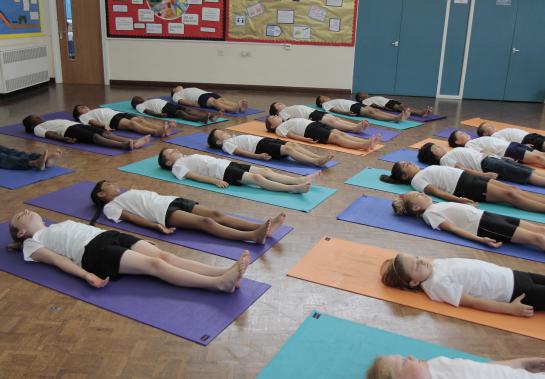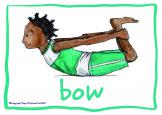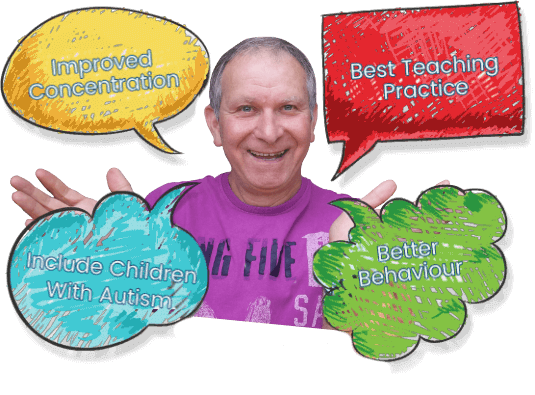Still Crazy after all these Years (of Children's Yoga)


Bloomin’ Bonkers Yoga or Still Crazy after all these Years (of Children's Yoga) … Apologies to Paul Simon
Michael Chissick ponders how being a Reflective Practitioner helped to improve his yoga teacher training programme in Special Needs Schools
Background
I deliver Training which empowers Teachers and Teaching Assistants to deliver yoga to their students as part of the PE /PSHE curriculum, with confidence and a big smile. And I do it (or rather have been doing it) by leading the lesson and demonstrating by example.
I’m Crazy
In fact, I often think I am crazy to do what I do. That is, putting myself in front of a class of students on the spectrum, of mixed ability, that I’ve never met, whose individual needs I am not aware of, who may find me frightening, whose needs may be highly complex, who don’t know me; when the expectation from the adults present is that I deliver an amazing lesson, when every student is engaged and achieves. It’s bonkers!
My Approach
My approach had been simple. I had five lesson plans up my sleeve and when the class came in, I would assess the students and decide which plan to use, A, B, C, D or E.
A bit hit-or-miss I hear you say.
Thankfully, mostly hits, and most times this approach worked very well. However, I had for a long time been aware that there were holes in this approach that could dilute the quality of the training, preventing staff from getting full value from the day.
For example, if a student (or students) has a meltdown, which can happen for any number of reasons, that could result in the disruption of the lesson and perhaps student and their adult support having to leave the session and therefore missing the training.
Sometimes things can go too smoothly (It happens!) But on the day, I want to be able to show staff how to adapt the postures or activity should a student be reluctant to engage. After all, engagement is the main goal here and reluctance is an everyday part of teaching students with ASD.
So, I Act
So, I decided to act. I took the best aspects of my existing approach and combined them with a new approach which has resulted in much better, more rounded, more
all-encompassing training day.
The New Structure
The new structure of the day allows me to show staff six sessions covering THREE different sections of ability/learning styles, which I define as:
- STUDENTS WITH VERY COMPLEX NEEDS
- STUDENTS WHO ARE LESS COMPLEX/MLD
- STUDENTS WHO ARE MORE ABLE /MLD
In each section, the first session will involve Staff only, in a very interactive and practical way, when they will learn how to structure each lesson; how to teach yoga to whole groups, lesson planning and classroom management specifically in the yoga lesson, the most successful & engaging yoga games and activities. Plus, a variety of ways to deliver sequences, self-esteem enhancement and calming & relaxation techniques. They will also learn how to ensure that as many children as possible are engaged and included.
The Staff session will be followed immediately by a lesson with students of that ability level, when Staff will see how it works in practice.
This has proved to be a winner because by the second session staff have a greater understanding of:
· The structure of the lesson
· The individual elements of the lesson
· Their role in the lesson
· How to adapt postures
· How to engage reluctant students
Above all, from their initial session, staff can appreciate how the yoga can be such fun and at the same time would have experienced ‘being in their students’ shoes’. What a difference that can make to staff confidence and their eagerness to deliver the programme.
Remote Training
I was so encouraged by the success of the new approach, especially the staff sessions, that I realised that I could transfer much of this approach into my Remote Training Sessions. Obviously, and for me sadly, no students would be present. However, asking adult staff to pretend to be students and having some of the staff be the ‘adults in the room’ proved to be monumental and my sadness soon disappeared.
And such fun. I have not laughed so much for years. Again, putting staff into students’ shoes widens their understanding of how well teaching yoga this way works.
Remote training has enabled me to give schools more value for money, because I have no travelling costs and therefore my rates are lower, and my improved carbon footprint gives me great pride. It’s still hard work. I normally deliver three 1-hour sessions over three twilight sessions, followed up with a Scheme of Work containing lesson plans for the whole of the academic year for each ability/learning style group and my visual resources. Recently I delivered training to around seventy - five staff over the three sessions which translated to an excellent cost per head for the school.
Final thought
I hope this article has given you an insight, albeit briefly, into what goes on in my world of yoga for children & young people with Autism. I also hope that fellow Trainers are encouraged to keep looking at their approaches with a ‘Learn- by-Doing’ approach as well as being reflexive practitioners, to improve the quality of their training which ultimately improves the quality of teaching that children & young people with Autism deserve.
Interested in Teacher Training in your School? Simply complete the form and I'll get back to you
(c) Copyright 2023 Michael Chissick & Yoga at School. Not to be reproduced or distributed without permission




